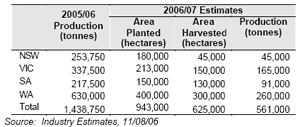Australia
October 6, 2006
Australian Oilseeds
Federation - Crop Report October 2006 (excerpts)
 The Australian canola crop has
been revised down by a further 30% to its lowest level in well
over a decade. The falls have been greatest in NSW and South
Australia, although crops are being grazed or cut for hay/silage
in all states. The current scenario will see the east coast
short of canola for its domestic market and essentially removes
Australia from the export market, with the exception of some
tonnage from WA. To further compound the problems, the hot dry
finish to the season is likely to see oil contents below
average, although there are some offsetting factors to this as
identified in the state reports. It should be noted that given
the current conditions and the lack moisture experienced by
crops, it is difficult to estimate the yield potential and thus, The Australian canola crop has
been revised down by a further 30% to its lowest level in well
over a decade. The falls have been greatest in NSW and South
Australia, although crops are being grazed or cut for hay/silage
in all states. The current scenario will see the east coast
short of canola for its domestic market and essentially removes
Australia from the export market, with the exception of some
tonnage from WA. To further compound the problems, the hot dry
finish to the season is likely to see oil contents below
average, although there are some offsetting factors to this as
identified in the state reports. It should be noted that given
the current conditions and the lack moisture experienced by
crops, it is difficult to estimate the yield potential and thus,
variation to final numbers can be expected. Overall, the
estimates for WA would appear to relatively stable while there
is still further downside potential for the east coast.
NSW continues to experience
desperate conditions, with 94% of the states drought declared.
There is no subsoil moisture and there has been little or no
rain over the winter and this has impacted the total cropping
sector including canola. The recent hot windy conditions are
seeing crops deteriorate daily. The north is holding up with the
small area of 10,000 hectares expected to see yields in excess
of 1 tonne per hectare. The central region is estimated to have
less than 10,000 hectares that will be harvested and yield
potential is well below average. In the south, the traditional
dryland area has been most impacted and large areas grazed or
cut. The combined yield from the irrigated area plus the north
will account for half the total crop in NSW. In total, it is
estimated that only 45,000 hectares will be harvested, however,
with the crop still some weeks from harvest this area could
decline.
Conditions in Victoria have not
been as bad as NSW. Despite this, there will be virtually no
canola harvested in the Mallee and areas in the Wimmera and
North East have been reduced by 50% and yields downgraded
significantly. However, on the positive front, the western
district is holding up quite well. This region does need
rain to finish the crops, but proportionally the rain required
is relatively low compared to this region’s normal rainfall. At
this stage, area has been left unchanged for the western
districts and yields revised down slightly. Overall, Victoria is
estimated to produce 165,000 tonnes, but this is dependent on
the western district crops receiving a kind finish to the
season.
Conditions in South Australia
are variable. There are some areas that are still looking
reasonable – higher rainfall areas of the mid and lower north
and the lower end of the Eyre Peninsula. However, in the low
rainfall areas, yields are only expected to be in the region of
0.2-0.3 tonnes per hectare. The state has been experiencing very
hot temperatures and this will further adversely impact the
crops. Windrowing is about 2-3 weeks off, although
there are reports of growers looking to direct head crops.
Insect damage has also been an issue, in particular, diamond
back moth and aphids. Both area harvested and yields have been
revised down to an estimated 90,000 tonnes, with further
downside possible.
Production outlook in Western
Australia has improved a little with some continuing lighter
rainfall, in particular, crops south of the Great Eastern
Highway have benefited from this. Crops in the North, where they
still exist will be being swathed or may be being harvested next
week – a few days rainfall or hot weather will delay or bring it
on. Harvest is close to commencing in Esperance and thus, long
season varieties that started late may not benefit from a soft
finish as had been hoped for. There have been widespread reports
of rising canola aphid numbers requiring control this season. It
appears that the current season has favoured the rapid build up
of the aphids whilst the natural predators and parasites are, at
present, lagging behind in their effectiveness. WA estimates
show less variability than the east coast. Harvestable crop area
is estimated at around 300,000 hectares and production estimates
have been increased slightly to 260,000 tonnes. Oil content,
while down on the excellent figures of recent seasons, is
expected to average around 42%.
Watch the canola crop progress
at the Virtual Canola Crop site.
http://www.australianoilseeds.com/info/virtual_canola_crop
|